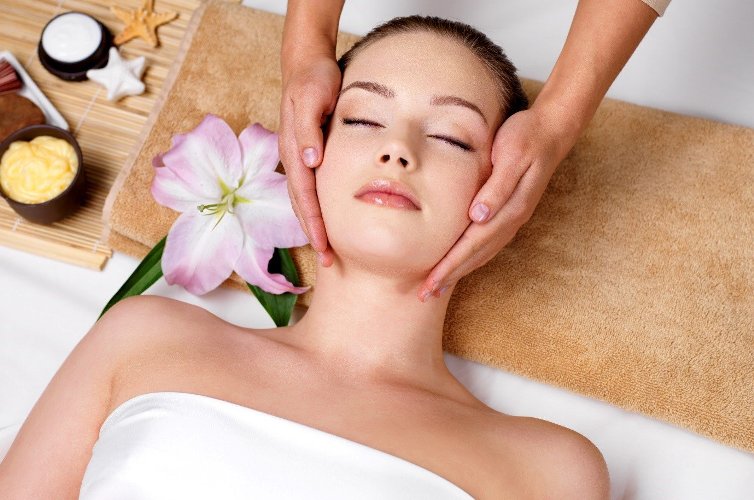
Massage is often used as part of a broader treatment plan for jaw pain known as temporomandibular disorder. COURTESY
Whether it’s with a jade roller, a gua sha or simply your fingers, facial massages are all over social media, from TikTok demonstrations to Instagram ads.
They make lofty, appealing promises – claiming to improve blood circulation, reduce puffiness and water retention by stimulating the lymphatic system, combat wrinkles and sagging skin or even sculpt away double chins. But dermatologists doubt the efficacy. Dr Cara McDonald, a specialist dermatologist based in Victoria, notes that “there are not many randomised control trials, which are the gold standard in scientific research”. Sydney-based dermatologist Dr Natasha Cook is even blunter, calling the benefits “fundamentally mythological”. “Anything that’s visual will be popular on Instagram and TikTok platforms. It doesn’t mean they work,” Cook says. “It’s an entertainment piece, I think that’s all it is. If you understand the essence of ageing … the action of rolling or massaging just does not equate with fixing that, except for [being] a glorified facial. “Let’s face it … we’re all insecure as people, so anything that can make us feel less of that is always appealing. That’s the key with the beauty industry, it buys into that fundamental fear.” McDonald agrees that “consumers should be alert to sales and marketing campaigns via influencers and social media accounts”. But, she acknowledges, the tools are “relatively cheap” in the realm of skincare doodads and massaging is easy, so she understands the appeal. After all, “skin is in and with the dominance of social media and self-comparison”, people are always looking for the next trendy way to self-optimise. But as physiotherapist David O’Brian, a co-owner of Glebe Physio in Sydney, explains, even if facial massage doesn’t deliver benefits to the skin, it can be good for facial muscles.
Massage is often used as part of a broader treatment plan for jaw pain known as temporomandibular disorder – which can be “very painful and scary”, O’Brian says – and the condition’s associated headaches. “There are many muscles that attach your jaw to different parts of your skull and neck, and facial massage can help to reduce the tone in those muscles to assist in getting it moving again,” O’Brian explains. “Your physiotherapist will usually have you lying on your back with your head resting comfortably on a pillow. They then provide gentle pressure to the muscles that they believe are involved in your pain, usually with their fingertips or thumbs.” Effective facial massage usually provides “some immediate relief” from the jaw pain or headache. O’Brian says it is “difficult [but] possible” to try the technique at home. “The easiest muscles to attempt this on are the masseter muscle and the temporalis muscle. You can find the masseter muscle towards the back part of your cheeks, towards your ears,” he says. “The temporalis muscle can be found in the front part of your temples and covers a large portion of the side of your skull. Both muscles can be felt bunching up underneath your fingertips when you clench your jaw. “If you Google these muscles, you can see roughly where they sit on your skull and face. Apply gentle pressure across the muscles, and if you find any spots that are particularly tender, press into them.”
But other muscles can also be affected, so if you’re experiencing jaw pain and dysfunction, O’Brian advises visiting a physio or dentist. Facial massage usually forms just one part of a much bigger treatment program, and “can be helpful in assisting with pain and dysfunction but shouldn’t be used as the sole treatment method”. A health professional will have “a much more detailed knowledge of the muscles of your face and neck, and can also help to provide advice on how to prevent the problem from recurring”, he says. O’Brian agrees with Cook and McDonald that facial massage can be “a nice way to help reduce stress and relax”, especially when combined with meditation or mindfulness. But if you do try it at home – whether with a vibrating gadget, a gua sha that hugs your jaw or your fingertips – don’t overdo it. McDonald warns that there is “certainly a risk of too much of a good thing”. “Excessive massage can cause skin inflammation or irritation and will have negative effects in sensitive skin types,” she says. O’Brian says that people with skin conditions like psoriasis and dermatitis should avoid massaging their face. And if you’re interested in the practice for its effect on the skin, rather than the muscles, Cook suggests laser treatments are “a much better way to go”. “Would it be really nice if [facial massage] could do that [improve skin]? Of course it would be … It probably does feel super relaxing, and it probably does relieve stress,” she says. “But is it really a skin treatment? I just don’t really think so.”






0 Comments